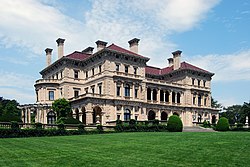The Scottish Lace and Textile Workers' Union was a trade union representing textile workers in Scotland. The union was founded in 1890 as the Newmilns...
3 KB (329 words) - 09:47, 18 July 2023
Blacksmiths and Structural Workers, Northern Ireland Professional Footballers' Association 1983: Scottish Lace and Textile Workers' Union 1986: Amalgamated...
26 KB (2,595 words) - 05:29, 13 July 2025
Boot, Shoe and Slipper Operatives Scottish Lace and Textile Workers' Union Screw, Nut, Bolt and Rivet Trade union Society of Shuttlemakers Tobacco Mechanics'...
14 KB (815 words) - 12:04, 6 February 2025
The textile industry is primarily concerned with the design, production and distribution of textiles: yarn, cloth and clothing. Cotton is the world's...
46 KB (6,133 words) - 12:38, 15 June 2025
Textile is an umbrella term that includes various fiber-based materials, including fibers, yarns, filaments, threads, and different types of fabric. At...
118 KB (10,458 words) - 04:50, 15 July 2025
Canadians and Scottish Americans as the five million remaining in Scotland. By the start of the eighteenth century, a political union between Scotland and England...
54 KB (7,641 words) - 01:37, 25 May 2025
Industrial Revolution (redirect from The Industrial Revolution and it's consequences)
craft workers their jobs. The Luddite movement started first with lace and hosiery workers near Nottingham, and spread to other areas of the textile industry...
220 KB (25,223 words) - 06:09, 24 June 2025
Joseph L. White, The Limits of Trade Union Militancy: The Lancashire Textile Workers, 1910–1914 (1978). Andrew Miles and Mike Savage, The remaking of the...
68 KB (8,674 words) - 13:29, 11 June 2025
to secure harmonious and cheerful co-operation". The lace manufacturers of Nottingham told the 1875 Royal Commission that workers in the industry fell...
35 KB (3,625 words) - 12:44, 8 July 2025
Fulling (category Textile treatments)
the 5th century BC. Scotland, then a rather remote and un-industrialized region, retained manual methods into the 1700s. In Scottish Gaelic tradition, this...
11 KB (1,233 words) - 15:42, 17 July 2025
Work song (section Definitions and categories)
cultivation and herding songs. Gioia also highlighted the industrial or proto-industrial songs of cloth workers (see Waulking song), factory workers, seamen...
25 KB (3,320 words) - 20:28, 9 June 2025
1970, and then all the other minor unions in the industry. The long-established Amalgamated Society of Operative Lace Makers and Textile Workers also joined...
6 KB (484 words) - 16:20, 30 September 2023
Gilded Age (section Rise of labor unions)
he found the standard of living of unskilled workers was about the same in the two cities. Skilled workers in Pittsburgh had about 50% to 100% higher standard...
151 KB (17,202 words) - 13:38, 20 July 2025
Factory Acts (redirect from Lace Factory Act 1861)
Act) limited the work week in textile mills (and other textile industries except lace and silk production) for women and children under 18 years of age...
130 KB (14,975 words) - 09:08, 19 July 2025
Ann Macbeth (category Women's Social and Political Union)
at the Women's Institute and participated in programmes to alleviate local economic hardship. In her book Embroidered and Laced Leatherwork Macbeth lamented...
20 KB (1,957 words) - 07:14, 24 May 2025
Distributive and Allied Workers remain TUC members. Of the former members of this section, the Educational Institute of Scotland, Fire Brigades Union, Hospital...
74 KB (1,484 words) - 23:09, 28 August 2024
Wool (category Harv and Sfn no-target errors)
Wool is the textile fiber obtained from sheep and other mammals, especially goats, rabbits, and camelids. The term may also refer to inorganic materials...
44 KB (5,024 words) - 23:04, 18 July 2025
in textile factories. Bleaching and dyeing works were included by the acts of 1860 and 1862;[which?] lace factories by that of 1861; calendering and finishing...
74 KB (11,620 words) - 10:24, 13 March 2025
for workers, oversee working conditions, and limit working hours. At first this applied to a very limited number of industries like lace-making and finishing...
259 KB (34,908 words) - 08:46, 19 July 2025
David Mauchan (category Scottish men's footballers)
Elizabeth (1887–1921), and John (1889–1976), and one younger brother, William (1897–1976). His father was one of many workers at lace manufacturers Johnston...
8 KB (840 words) - 21:16, 24 March 2025
Kebaya (section Lace kebaya)
traditionally made from lightweight fabrics such as brocade, cotton, gauze, lace, or voile and sometimes adorned with embroidery. The front is secured with either...
105 KB (12,459 words) - 10:58, 17 July 2025
A. J. Mundella (section Legacy and reputation)
made lace on a frame in their home and was regarded as adept at this work but, nonetheless, she too was poorly paid and after rent for housing and for...
67 KB (9,018 words) - 11:49, 17 July 2025
quotas, and a variety of other government regulations. Proponents argue that protectionist policies shield the producers, businesses, and workers of the...
94 KB (10,819 words) - 01:24, 18 July 2025
English Poor Laws (redirect from Poor laws in England and Wales)
left surviving workers in great demand in the agricultural economy. Landowners had to face the choice of raising wages to compete for workers or letting their...
74 KB (8,701 words) - 18:10, 3 January 2025
Qipao (section Fabric and textile)
bell-like sleeves, and black lace frothing. Starting from that, the priority of cheongsam moved from a political expression to an aesthetic and ornamental emphasis...
76 KB (8,294 words) - 14:27, 18 July 2025
Mary (name) (category Scottish feminine given names)
1929/1930), American aid worker Mary Macmaster (born 1955), Scottish harpist and singer Mary MacPherson (1821–1898), Scottish Gaelic poet Mary Macpherson...
200 KB (24,153 words) - 03:15, 19 July 2025
Maria (given name) (section Variants and usage)
American author and educator María Josefa Sancho de Guerra (1842–1912), Spanish Roman Catholic nun Maria Sandel (1870–1927), Swedish textile worker, writer,...
185 KB (22,173 words) - 02:30, 20 July 2025
Crinoline (section Crinolettes and 1880s revival)
worn by some factory workers, leading to the textiles firm Courtaulds instructing female employees in 1860 to leave their hoops and crinolines at home....
51 KB (5,470 words) - 03:08, 13 June 2025






















